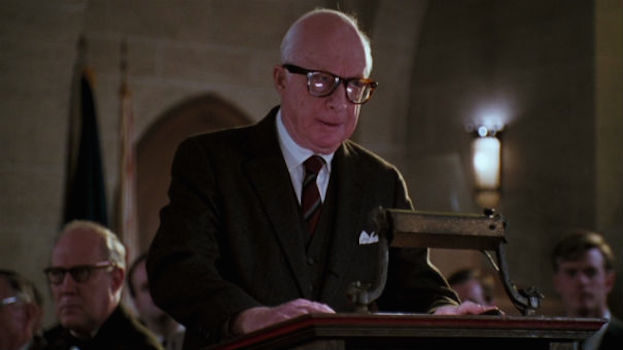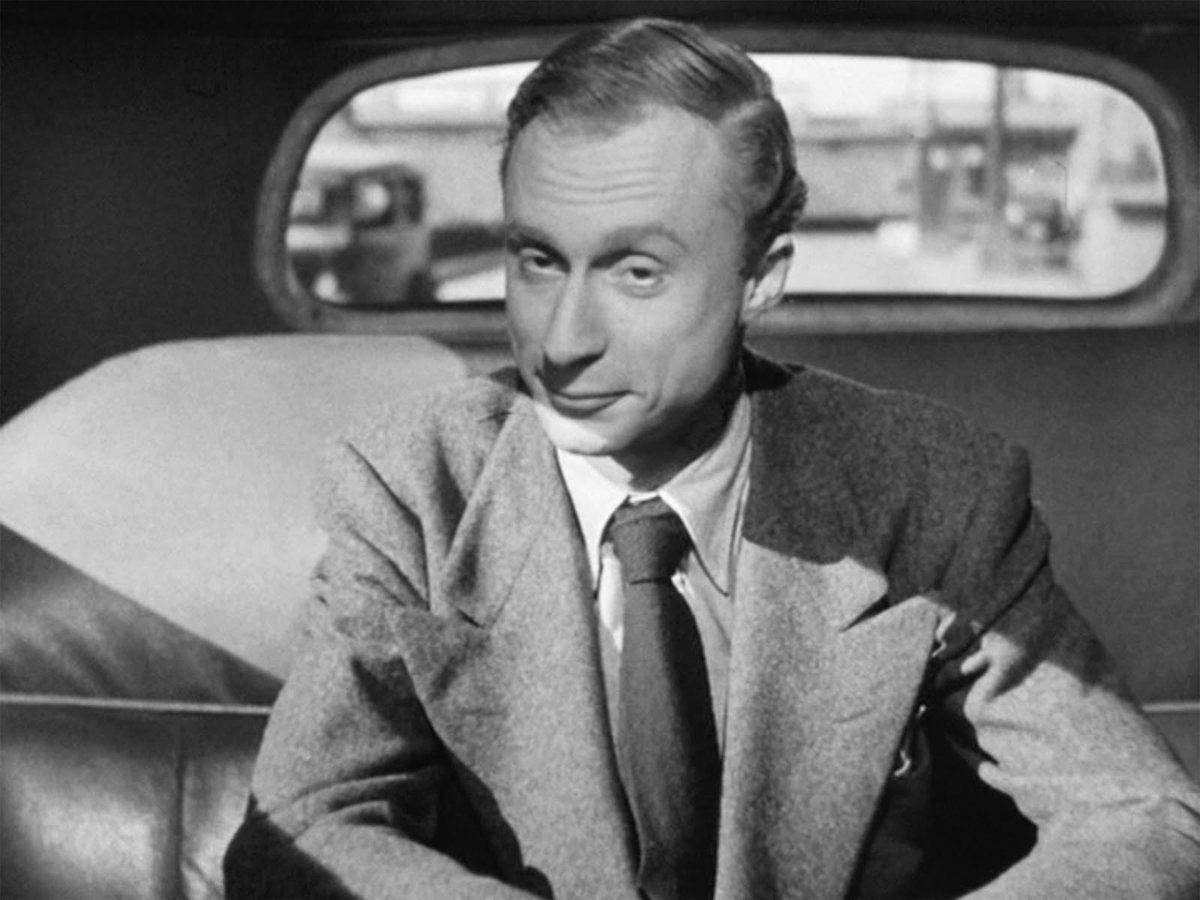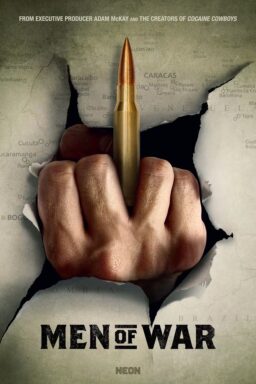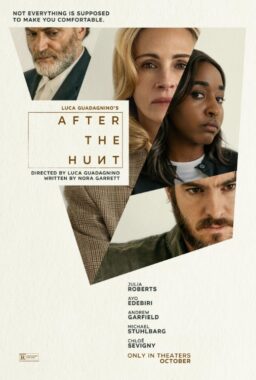“Norman Lloyd is the history of our industry up to now.”—Karl Malden in Matthew Sussman’s 2007 documentary, “Who is Norman Lloyd?”
And indeed he is. At 100 years old, Lloyd has built one of the most extraordinary careers in show business, and he shows no signs of stopping. His most memorable roles were never the leads, yet they were all utterly invaluable, often distinguished by his Cheshire-like smile and the mischievous glint in his eye. Though he was often cast as villains who functioned as a force of destruction or conformity, Lloyd proved to be the polar opposite of his characters. He had a penchant for working with trailblazers who achieved infamy by breaking out of the patterns and formulas of their peers. They were artists who believed in living life on their own terms and found indelible ways of conveying this philosophy through their work.
Lloyd’s own history as a nonconformist began in his early 20s, when he was cast as Cinna the poet in Orson Welles’s 1937 staging of “Julius Caesar,” which happened to be the first-ever production of Welles and John Houseman’s historic Mercury Theatre company. The adaptation was courageous in how it reflected anti-Hitler sentiment at a time when it was still taboo, and Lloyd was tasked with delivering the play’s first, immortal line, “Caesar, beware the Ides of March.” The actor also appeared in “Crime,” a play directed by Elia Kazan, one of the most famous members of the Group Theatre, which Lloyd still considers “the greatest we had,” according to his Screen Actors Guild interview conducted by Elliott Gould this past January. He saw firsthand how Kazan’s use of Method acting changed film acting forever. Yet “Crime” was most memorable for Lloyd because it introduced him to the actress Peggy Craven, whom he would marry in 1936. Their marriage lasted for 75 years until Peggy’s death in 2011 (she was 98).
Though sadly no recording exists of these productions, Lloyd’s theatrical exuberance is on delicious display in a 1972 televised version of Percy MacKaye’s play, “The Scarecrow” (available on Netflix), where he portrays the gleeful, demonic puppet master of a literal straw man (Gene Wilder, two years before bringing his own creation to life in “Young Frankenstein”). A beguiling Blythe Danner also appears as the scarecrow’s love interest, and there’s a deeply chilling moment toward the end when Lloyd’s face breaks into a ghoulish grin before vanishing into the shadows. The friendship Lloyd struck up with Danner on the set ultimately led him to get cast as Dr. David Auschlander in her husband Bruce Paltrow’s groundbreaking television series, “St. Elsewhere.” Its realistic depiction of daily life at a hospital influenced countless subsequent shows including “E.R.” and “Grey’s Anatomy.”

Auschlander was originally intended to be on only four episodes (Lloyd is credited merely as a guest star on the 1982 pilot), but became a regular for the remainder of the series during its six seasons, even appearing in the last, much-discussed scene of the finale, which suggests that the entirety of the show may have existed within the mind of an autistic boy. As the hospital administrator, Auschlander’s agnostic intellectualism could have merely come off as stuffy, but Lloyd brought an energetic life to the character that made him irresistible. He even got to display his comedic chops in an especially wonderful episode where Auschlander experiments with medical marijuana and ends up causing a scene in a convenience store, exclaiming to a befuddled police officer, “Wait till you get a taste of this beef jerky!” Yet it’s his first scene on “St. Elsewhere” that is surely the most prophetic. A group of doctors (including a young Denzel Washington) are surprised to see Auschlander, who was recently diagnosed with cancer, climbing the stairs to “keep in shape” rather than taking the elevator. Dr. Westphall (the late Ed Flanders) looks at his colleague wistfully before replying, “Knowing him, he’ll probably outlive us all.”
It makes sense that Lloyd would have a landmark career on TV as well, considering that his first screen credit was in 1939’s “The Streets of New York,” the earliest surviving footage of American broadcast television, which can be viewed at New York’s Museum of Television and Radio. His ageless presence has graced episodes of “The Twilight Zone,” “Star Trek: The Next Generation” and “Modern Family,” to name a few, yet it his six key collaborations with game-changing film directors that serve as the chief focus of this retrospective. Now let us take a stroll through cinema history with the man who has seen it all…

Lloyd & Hitchcock
What better way to make one’s film debut than by embodying the elusive face of evil in a thriller directed by the Master of Suspense? It was Houseman who recommended Lloyd to Alfred Hitchcock for the role of Fry, the titular troublemaker in 1942’s “Saboteur.” With his sly expressions, Lloyd’s performance could have worked equally well in the silent era—he doesn’t have to utter a word for us to imagine the unspeakable thoughts brewing in his mind. He can rattle the nerves of viewers simply with a glance in appreciation out his cab window at the catastrophic sight of a downed ship (which, in actuality, was footage of a capsized troop transport that Hitchcock ordered to be filmed). Perhaps the behind-the-scenes story Lloyd has been asked to recount most often throughout his career is the process of how Hitchcock shot the picture’s famous climax, where Fry hangs off the Statue of Liberty before falling to his death. It’s a sequence that has aged astonishingly well, and looks even more convincing than similar effects in “Rear Window,” “Vertigo” and “North by Northwest.”
Lloyd first saw the entire sequence, shot-for-shot, in the form of a storyboard scroll. The statue’s hand, torch and balcony were built to scale, and Lloyd takes pride in how he was able to do a backflip off the railing himself (“When you’re 26, you can do anything,” he told Gould). To create the illusion of falling, Lloyd sat on a swiveling saddle mounted on a pipe that was painted black against a black background serving as a pre-color-era green screen. As the camera swooped up, Lloyd performed a series of “balletic movements” that made it look as if he were hurtling through space. Though Hitchcock later thought it was a mistake to have the villain hanging off the statue in a prolonged moment of suspense, rather than the hero, the scene stands as an excellent example of the Master’s manipulation. Fry may be pure evil, but the sight of his body clinging for dear life as the stitching in his sleeve (held onto by the hero, in a feeble attempt to save him) slowly rips apart, inspires feelings of primal empathy in the viewer. After many scenes of wall-to-wall music, this moment contains nothing but naturalistic sounds—the wind, the distant horns of ships and the murmuring of tourists scurrying far below. Once Fry sees that his sleeve is ripping, he realizes in stunned silence that he’s doomed. Following an early screening of the picture, writer Ben Hecht quipped, “Should’ve had a better tailor.”
It’s one of the great set pieces in Hitchcock’s career and instantly gave Lloyd cinematic immortality. He would go on to appear in another of the director’s classics, 1945’s “Spellbound,” as well as many episodes of “Alfred Hitchcock Presents.” When he became a marginal victim of the blacklist, Hitchcock hired him as an associate producer and frequent director on his television program, thus leading them to become lifelong friends. In Ted Haimes’ 1999 documentary, “Dial H for Hitchcock,” Lloyd fondly remembered sitting next to the director’s wife and vital collaborator, Alma, during a screening of her husband’s final triumphant comeback, 1972’s “Frenzy,” and watching her burst into tears of joy.

Lloyd & Renoir
Just as “Saboteur” was an ode to the resilience of the American spirit in the face of terrorism, Jean Renoir’s overlooked 1945 gem, “The Southerner,” celebrated the sacrifice and boldness of an American family who set out to create a new life for themselves on the farm. Rather than settle for financial security by working for a factory, Sam (Zachary Scott) wants to be his own boss. Cinematographer Lucien N. Androit (“And Then There Were None”) beautifully accentuates the vastness of the fertile landscape, as Sam drags his wife, children and cantankerous granny (scene-stealer Beulah Bondi) to a broken-down farm house, leading to a very funny visual gag of the old biddy refusing to leave her rocking chair that has been propped in his truck (a la “Beverly Hillbillies”). The film’s strongest scenes involve Sam’s confrontations with a neighboring family, whose embittered patriarch reviles the success of others and will destroy their crops if only so he can have the land for himself. Lloyd plays the man’s son, Finley, a fiendish lad with spastic mannerisms and prone to childlike bouts of violence.
Lloyd has observed that he had a tendency to be cast as “arrested” characters, especially early in his career, and Finley is certainly no exception, lacking the suave façade of Fry while maliciously creeping around branches. Available on Amazon Prime, the film is quite moving and will assuredly stun Frank Capra fans upon the realization that Bondi played Jimmy Stewart’s genial mother in “It’s a Wonderful Life” the following year. It’s an amazing transformation, though Capra’s beloved holiday perennial was also a testament to the underrated actress’s versatility, which is witnessed when Stewart encounters the eerie, ghostly version of his mother during the film’s third act. In fact, Capra and Renoir shared an endearing humanism that ultimately set the tone for many of Lloyd’s pictures to come. In his Emmy TV Legends interview, the actor shared his belief that Renoir’s 1939 masterpiece, “The Rules of the Game,” contained the greatest line of dialogue in film, “The awful thing about life is this: Everybody has their reasons.”

Lloyd & Chaplin
Many of the most pivotal moments in Lloyd’s life have occurred on the tennis court. His favorite hobby has always been playing tennis, and he participated in matches with Spencer Tracy, Joseph Cotten and Charlie Chaplin. It was meeting Chaplin, of course, that left Lloyd in awe. He has memories of laughing uproariously at the iconic genius’s silent classics as a child, and believes Chaplin’s trademark persona of “the Tramp” to be “one of the greatest creations in dramatic history,” in how it “encompassed all of humanity.” Lloyd believed that the best directors brought some aspect of themselves to their work, and that is precisely what Chaplin did, allowing his own status as an English immigrant to influence the plight of his misfit characters.
The personal nature of Chaplin’s cinema was never more apparent than in 1952’s “Limelight,” which was recently released in a pristine Blu-ray edition courtesy of Criterion (among its special features is a new interview with Lloyd excerpted here). It’s heartbreaking to watch Chaplin lay bare his own anxieties with bracing candidness, juxtaposing his aging face with the specter of his faded comic persona. An unforgettable scene shows him performing a flea circus routine to thunderous applause, only to realize that the audience was in his head, as he stares out at a vacant theater. He awakens from this dream as a nearby bell ominously tolls. The film takes place in 1914 (the year of Lloyd’s birth), which is when Chaplin made his screen debut by directing a total of 17 comedic shorts. There are echoes in “Limelight” of “A Star is Born,” as the once popular clown Calvero (Chaplin) befriends and mentors a temporarily paralyzed ballerina (Claire Bloom), only to see her star rise while he sinks into obscurity. It’s also reminiscent of Billy Wilder’s “Sunset Blvd,” released two years previously, about an aging siren of the silent era (Gloria Swanson, who in one scene, performs a Chaplin impression). Buster Keaton, another towering comic filmmaker, makes cameos in both films, yet it is in “Limelight” where he truly shines, taking part in a sublimely disastrous musical duet with Chaplin. Watching them work out this routine was “one of the great events” of Lloyd’s life.
In the role of dance instructor Mr. Bodalink, Lloyd’s affable sanity is a striking contrast with most of his previous characters. He effortlessly exudes authority and moves with enough swiftness and vibrancy to make himself entirely credible in the role. Chaplin’s script overflows with gloriously poetic dialogue (“What a sad business, being funny,” “Life is a desire, not a meaning”), yet the sequences of performance—both comedy and dance—allows the director to tell his story purely through visuals, as in a silent film. Though he would go on to make two more features, “Limelight” does feel like a final work in many ways. Lloyd interpreted it as the story of Chaplin and his own young wife, Oona, whose children (including future star Geraldine) turn up as street urchins in the film’s first scene.
In the same year he made “Limelight,” Lloyd also directed an episode of the TV series, “Omnibus,” about the early years of Abraham Lincoln. Royal Dano played Lincoln, Joanne Woodward played Ann Rutledge and the script was written by James Agee. Filling the role of second unit director was a little-known filmmaker who had made one visually interesting yet deeply flawed feature that failed to impress viewers (including Lloyd, according to his Emmy TV Awards interview). His name was Stanley Kubrick.

Lloyd & Weir
Like many people in my generation, I first saw Lloyd in Peter Weir’s 1989 Oscar-winner, “Dead Poets Society,” where he played Mr. Nolan, the fearsome headmaster of an elite, all-boys prep school. He has enormous fun in the role, and earns laughs with small touches, such as how he wraps his hand around a doorknob like Nosferatu. Coming off his six years as Dr. Auschlander on “St. Elswehere,” Lloyd initially balked at Weir’s request to submit a taped audition, yet after a triumphant tennis match improved his mood, he decided to go ahead and throw his hat in the ring despite his misgivings. He ended up finding Weir to be in a league with the great filmmakers he had worked with, fulfilling the two things an actor wants from a director: “a constant interest in one’s performance and a preservation of the ego.” Lloyd also praises Weir as a humanist in how he empowered his fresh-faced cast to take an active role in forming their characters. “I enjoyed giving them a bad time,” Lloyd replied with relish in an interview on the film’s DVD edition.
Though the film may lack the brilliance of Weir’s 1975 classic, “Picnic at Hanging Rock” (set in the similarly claustrophobic confines of an all-girls school), “Dead Poets Society” left a profound impact on me when I discovered it as a frequently bullied junior high schooler. It’s almost unbearably poignant watching the film now, in light of Robin Williams’ untimely passing. His performance as inspirational English teacher John Keating may be the centerpiece, but it is the work of the terrific young actors—especially Robert Sean Leonard and Ethan Hawke—that anchors the picture in a tangible emotional reality. The best scene in the film focuses on Todd (Hawke) as Keating attempts to break the boy out of his shell in front of the class. Keating has Todd close his eyes as John Seale’s camera spins around him, blurring out his surroundings as he struggles to articulate the impromptu poem materializing in his mind. The metaphorical growth in one’s perspective signified by the students standing atop their desks is also a beautiful illustration of what cinema can achieve, expanding our worldview beyond our own limited experience. Like Calvero, Keating must fall in order for his youthful students to (literally) rise, and like Chaplin, Williams may have seen his own popularity fall over time, but his legacy is one for the ages.

Lloyd & Scorsese
The theme of art as a rejuvenating force in one’s life that reverberated throughout “Limelight” and “Dead Poets Society” continues in Martin Scorsese’s rapturous 1993 period drama, “The Age of Innocence,” an uncharacteristic change of pace for the master of adrenaline-fueled character portraits. In the rigidly structured, enclosed environment of New York’s high society circa 1870, art is the only entity granted to express the emotions that the characters must strain to repress, whether it be in the raw turbulence of an opera or the nude painting hanging on the wall at an otherwise civilized party. Dante Ferretti’s production design imprisons the characters, framing their faces with candles placed on either side like the bars of a cell, and Scorsese finds brilliant ways for his sets to emote in place of the characters, with crumbling embers in a fireplace (viewed in tight close-ups) signaling dramatic changes in tone. In many ways, the film is a throwback to the work of Douglas Sirk, complete with its lush Elmer Bernstein score and impeccable portrayal of a calculated, passive-aggressive society designed to stifle any humanity that threatens to disrupt its pageantry.
As subtle here as his character in Scorsese’s “Gangs of New Year” (set in NYC not long before the events of this film take place) was larger-than-life, the eternally mesmerizing Daniel Day-Lewis is quietly shattering as Newland Archer, a man contemplating a forbidden affair with a married woman, Ellen (Michelle Pfeiffer), whose eyes carry a refreshing spark of life. Once again embodying the malevolence of conformity, Lloyd shares a single scene with Day-Lewis and manages to stop the show. As the devious Mr. Letterblair, Lloyd must convince Newland that Ellen’s divorce will have horrendous repercussions on everyone. When Newland resists his words, Scorsese shows Letterblair light a cigar in such a way that makes him look as if he is loading the ammunition of his coercion (kudos to editing maestro Thelma Schoonmaker). No bullets are fired in “The Age of Innocence,” but the casualties are every bit as numerous. Curiously enough, two of Lloyd’s former co-stars, Geraldine Chaplin and Robert Sean Leonard, also make fleeting yet potent appearances in this film.

Lloyd & Apatow
There is currently no comedian in America more exciting or cutting-edge than Amy Schumer. The third season of her brilliant sketch show on Comedy Central served as a stupendously enticing prelude for her first starring role on the big screen in “Trainwreck,” the latest improv-based ensemble piece from director Judd Apatow. Apart from being his funniest film in years, “Trainwreck” also enables its star and screenwriter to deconstruct her own comic persona. The underlying substance in Schumer’s satire is what has made it so deeply compelling, and this film provides her with an opportunity to dig into the insecurities and traumatic personal crises of her promiscuous character. The romance she stumbles into with a smitten surgeon (Bill Hader, thoroughly charming) forces her to face the fear of intimacy that has made long-term relationships unthinkable in her life. It’s an excellent dramatic showcase for Schumer as it is a comedic one, and I was surprised by how moved I was by the end of the film.
As in his previous work, Apatow has assembled a colorful, talent-packed cast of supporting players and given each member at least one big moment to shine. Audiences will be surprised by just how funny LeBron James, John Cena and Ezra Miller are in their priceless cameos. Yet what warmed by heart most of all was watching Norman Lloyd bring down the house with expertly delivered ad-libs as “Norman,” the elderly companion of Schumer’s MS-stricken father (Colin Quinn) at an assisted living facility. These scenes are often painfully poignant, especially considering that Schumer’s real-life father has Multiple Sclerosis, and Lloyd’s quips lend them some much-needed levity, such as when he urges Quinn to join him in the therapy pool (“Meryl’s wearing a two-piece!” he replies, before smacking his lips).
Like Weir, Apatow empowers his actors to play a key role in creating their own characters, and encourages them to come up with their own lines. It proved to be a wonderfully liberating experience for the actor, though in a recent interview with David Poland, he confessed that he generally has little interest in modern films, since the Method has (in his mind) ultimately caused performances to become dull. He cites the classic quote, “One day, an actor forgot his lines, and thus, realism was born,” though in “Trainwreck,” the creative freedom provided for the actors results in work that is more honest and rich than practically anything else at mainstream multiplexes. It is a joy to watch Lloyd own the screen as effortlessly as he did in his film debut 73 years ago. In closing, I encourage you to check out Lloyd’s complete conversation with Poland in the episode of “DP/30” posted below, which was filmed during the 100-year-old actor’s first-ever press junket. Make sure to stick around until the very end, when Lloyd recounts his first onset attempt at a raunchy improvisation. Believe me, it’s worth the wait.
“Trainwreck” opens Friday, July 17th, in theaters.












